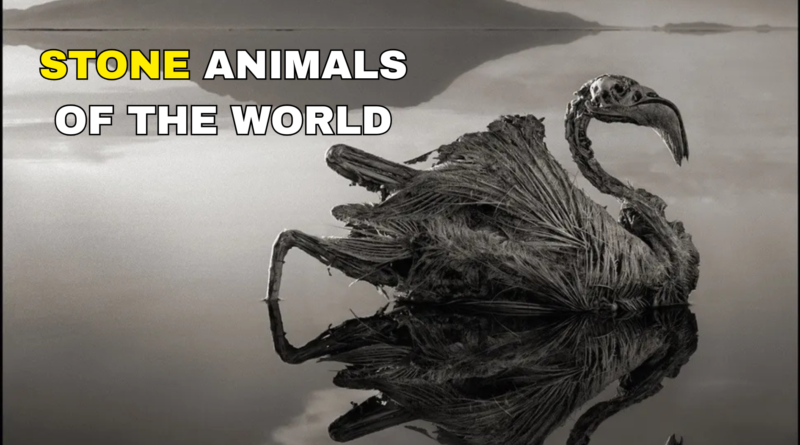PLACES WHERE ANIMALS TURN INTO STONE INSTANTLY
Across the world, there are strange places where animals and objects appear to turn into stone instantly. These places mix mystery, science, and legend, leaving scientists and locals amazed. From rivers that “petrify” creatures to ancient volcanic sites that preserve life in rock, these locations show how nature can transform living things into stone-like figures in surprising ways. Let’s explore some of the most mysterious and fascinating places where animals seem to turn into stone.
1. The Petrifying Well, Knaresborough, England
In the town of Knaresborough in North Yorkshire, England, lies a place called the Petrifying Well, also known as the Dropping Well. For centuries, people have been shocked by what they saw here objects left under the falling water turn into stone.
When you hang an item such as a shoe, a teddy bear, or even a leaf near the waterfall, it slowly gets covered in hard mineral deposits and turns into a stone-like shape. The water from the well contains a high amount of minerals like calcium and magnesium carbonate. As the water flows over the objects, it coats them layer by layer, eventually creating a stony covering.
In the past, locals believed that the well was cursed by a witch, and that anyone who touched its waters would be turned to stone. But now, science has explained that this is due to natural mineral deposition, not magic. Still, the sight is so strange that it feels almost supernatural.
2. Lake Natron, Tanzania
One of the most hauntingly beautiful and dangerous lakes in the world is Lake Natron, located in northern Tanzania, near the border with Kenya. This blood-red lake looks like it belongs to another planet.
Lake Natron is highly alkaline, with a pH level as high as 10.5, almost like ammonia. The lake’s temperature can rise to 60°C (140°F), and it contains high amounts of sodium carbonate and other minerals.
When birds or small animals accidentally fall into the lake, the harsh chemicals in the water cause their bodies to calcify a process that covers them in mineral layers and makes them look like they’ve turned to stone. The creatures are not instantly turned into rock, but the drying and mineralization happen so quickly that they appear frozen in time.
Photographer Nick Brandt once captured eerie images of animals preserved by the lake’s chemical reactions. The sight of perfectly still birds covered in white and gray mineral layers looks like nature’s own version of a stone statue.
3. The Petrified Forest, Arizona, USA
The Petrified Forest National Park in Arizona, USA, is another world-famous site where things have literally turned into stone but here, it’s not animals, it’s trees. Millions of years ago, this region was filled with lush green forests. Over time, volcanic ash and sediment buried the trees.
Instead of rotting, the wood absorbed minerals from the groundwater, such as silica and quartz, which slowly replaced the organic matter. After millions of years, the wood became petrified turned to stone.
Though no animals were fossilized here in the same way, the forest shows how organic material can be preserved perfectly in stone under the right natural conditions.
4. Pamukkale, Turkey
Pamukkale, which means “Cotton Castle” in Turkish, is another magical-looking site. It’s not exactly where animals turn to stone, but it’s famous for its petrifying hot springs.
The water that flows down the mountainside is rich in calcium carbonate, which forms bright white terraces that look like frozen waterfalls. When objects or plants are placed in the running water, they quickly become covered in chalky stone-like layers.
Ancient people believed that these springs had healing powers, while others thought they were created by gods. Today, tourists visit Pamukkale to see the natural mineral “stone coating” process in action.
5. Yellowstone Hot Springs, USA
The hot springs and geysers in Yellowstone National Park are also capable of creating stone-like coatings on anything left in the water. The hot, mineral-rich waters deposit silica, calcium, and other materials, which can preserve organic matter like leaves or small insects.
In some cases, animals that fall into these boiling waters can become mineralized quickly, forming a shell that looks like stone. Scientists studying the park have found small fossils and remains that turned hard because of the mineral reactions in the springs.
The Science Behind “Turning to Stone”
When we say animals “turn to stone,” it doesn’t mean they transform instantly like in a fairy tale. In most of these cases, it’s a chemical process called petrification or calcification.
Here’s how it happens:
Mineral-rich water touches organic material (like an animal or object).
The minerals slowly replace the original tissues or cover the surface.
Over time, the object becomes hardened, looking like stone.
In some places, like Lake Natron, this process happens very quickly within days or weeks giving the illusion of instant transformation.
Conclusion
From England’s magical Petrifying Well to Tanzania’s deadly Lake Natron, these places show how nature can mimic myth. What once seemed like witchcraft or divine punishment is actually a result of minerals, heat, and chemistry.
Yet even with science explaining it, these locations still carry a mysterious and eerie beauty. They remind us that Earth is full of wonders that blur the line between life, death, and stone where time seems to stop, and nature itself becomes an artist.




